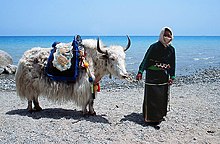Yak breeds

As yak races are called in their appearance and their meat and - milk yield distinctive breeds of Hausyaks . Despite the yak's long history of domestication, there aren't very many breeds. Targeted breeding was not common in the original nomadic economy and is limited, among other things, by the high level of aggressiveness of the bulls, which react immediately to disturbances with attacks during the mating season. However, phenotypic changes have occurred between populations , largely due to the geographical separation of widely spaced locations. For example, those in theMongolia distributed domestic yaks to a large extent polled. This makes it easier to deal with the animals and reduces the risk of injury in rank fights. However, it is by no means a desired breeding trait, since polled animals have a reduced ability to defend themselves against predatory game.
More targeted breeding has existed in the region of the former Soviet Union since the second half of the 20th century, and efforts are being made in China to improve domestic yaks in breeding. The yak breeds that have been distinguished so far are geographical breeds, whose breed-typical characteristics are less manifested than with European land cattle breeds in the middle of the 19th century. Be differentiated
Geographical races are distinguished only for China. In the other countries one cannot speak of definable yak races. In Mongolia, for example, the cattle trade has a long tradition, so that characteristic differences could not develop. Various aspects play a role in breeding in China. In addition to the meat and milk production, the production of yak wool is to be increased in the future.
See also
literature
- Jürgen Lensch, Peter Schley and Rong-Chang Zhang (eds.): The Yak (Bos grunniens) in Central Asia , Gießener Abhandlungen zur Agrar- und Wirtschaftsforschung der European East, Volume 205, Berlin 1996, ISBN 3-428-08443-8
